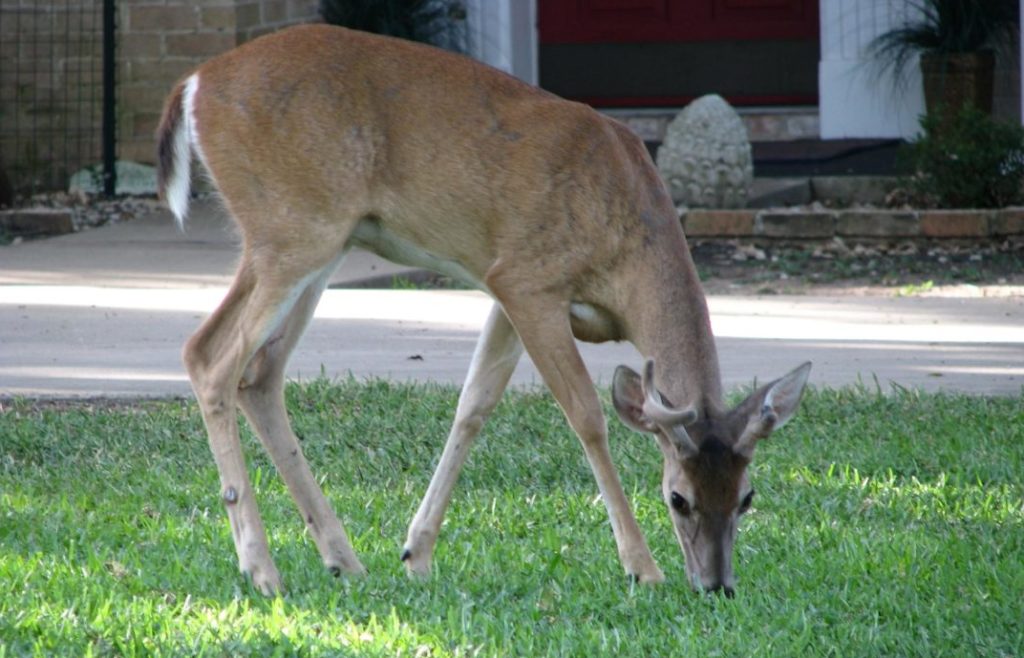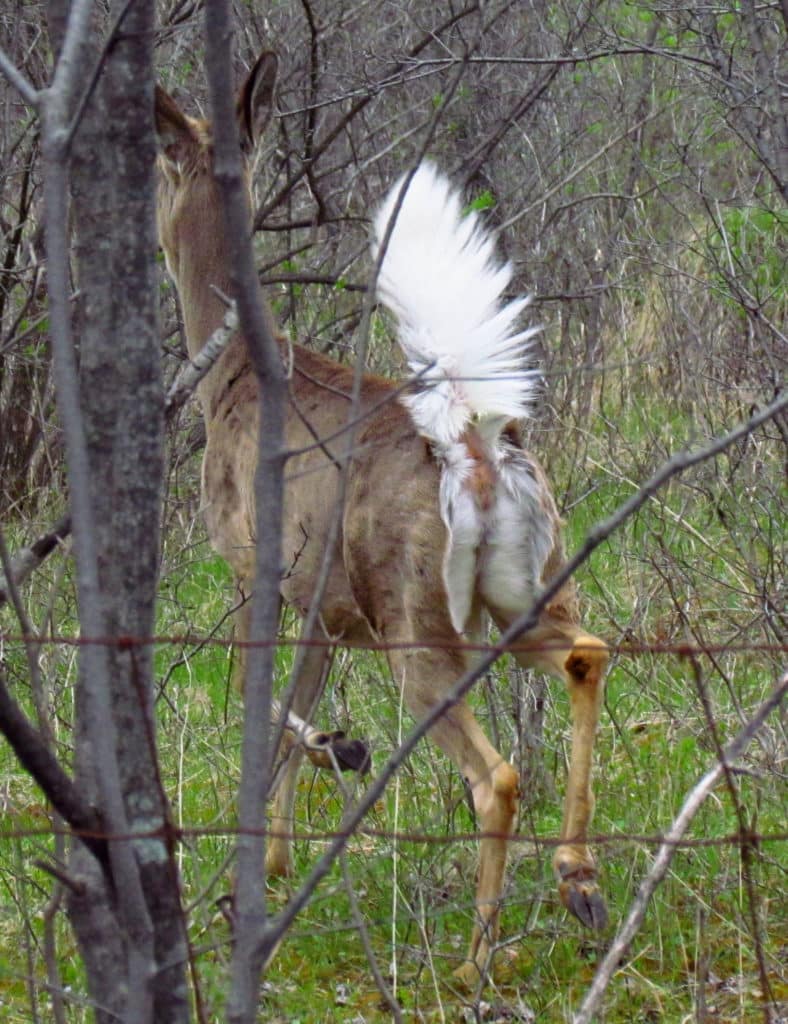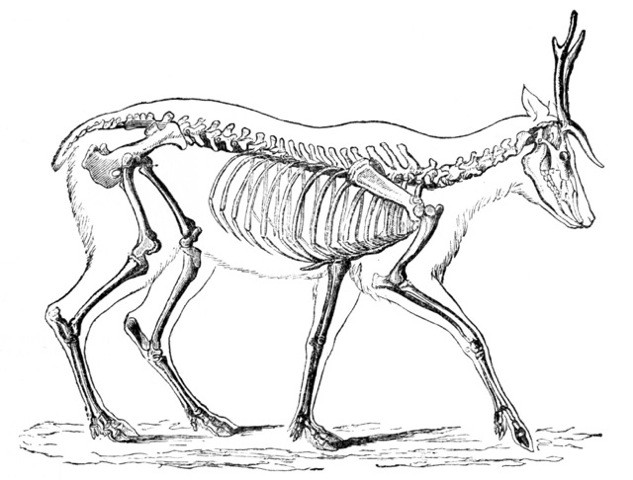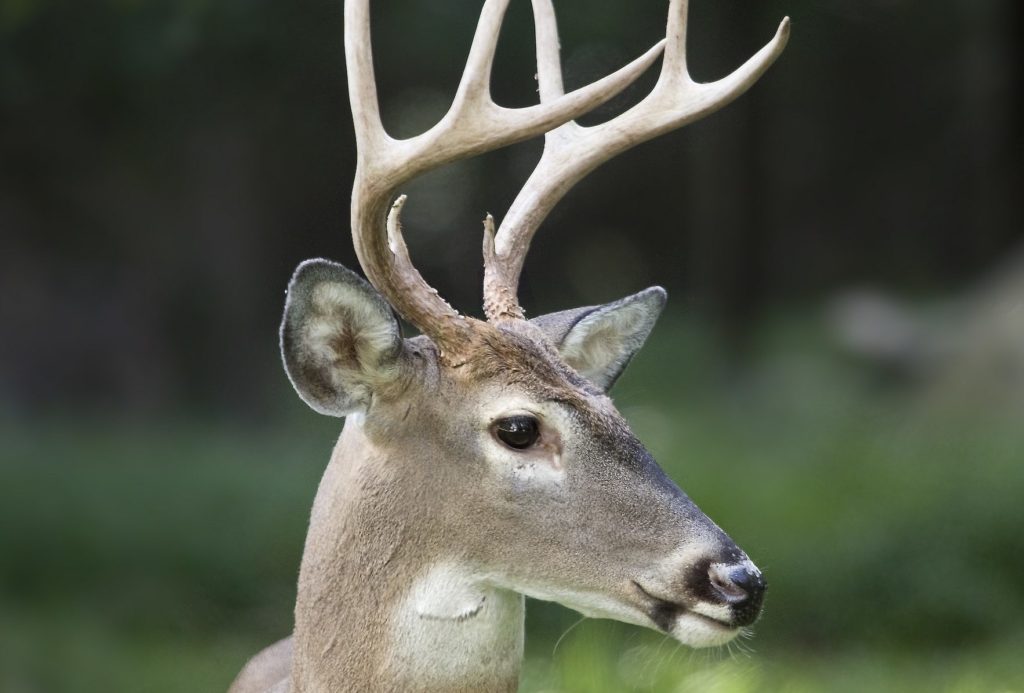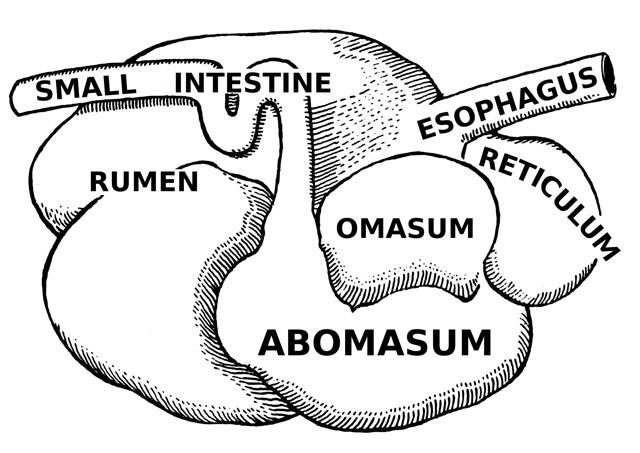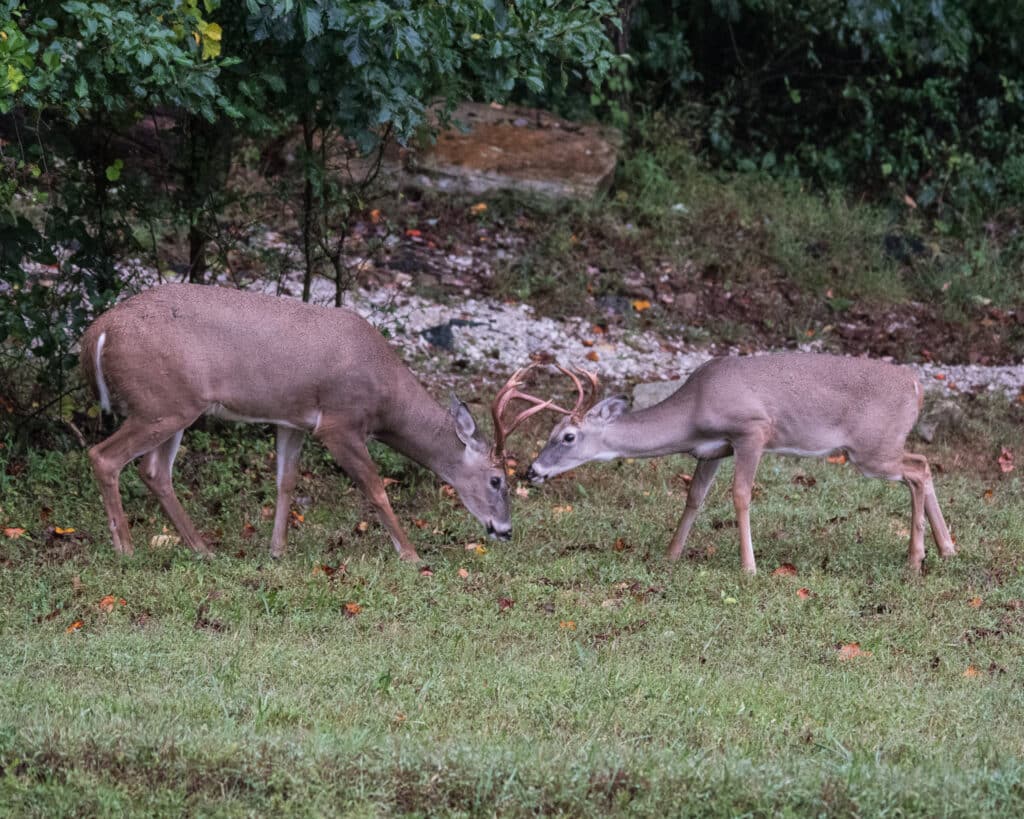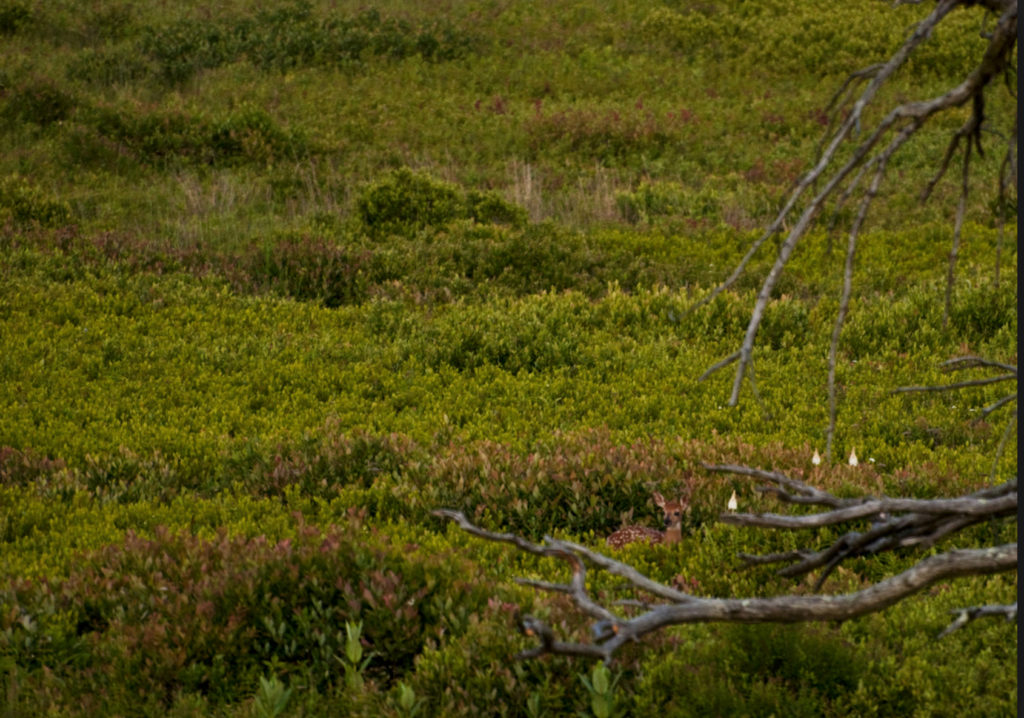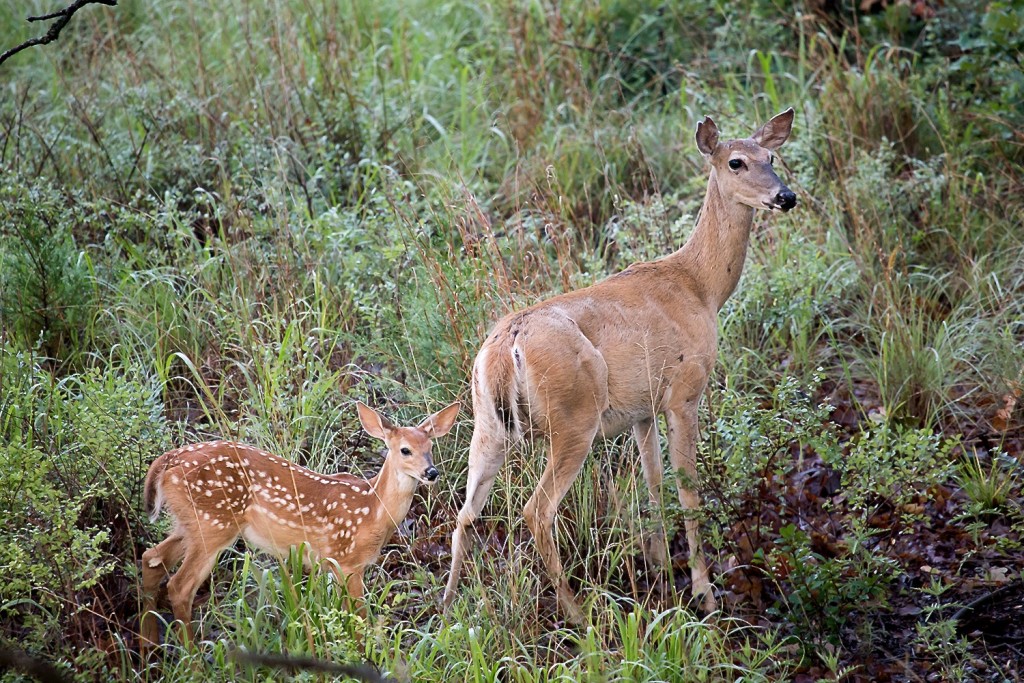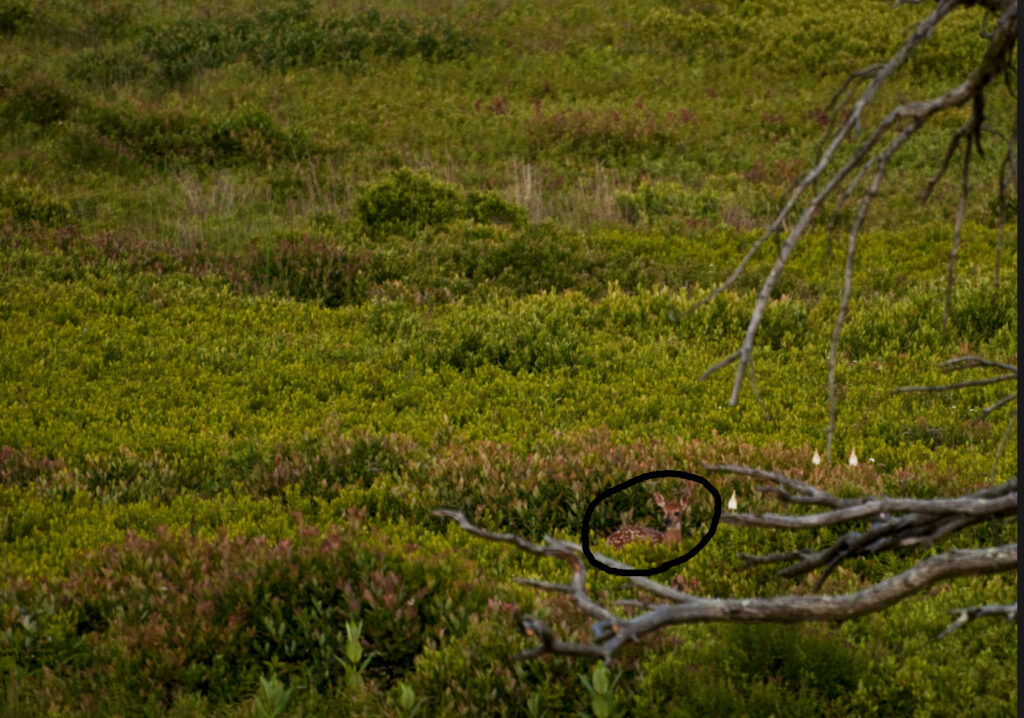Ask any child about deer, and Bambi, the fawn1 in Walt Disney’s beloved animated movie of the same name, will inevitably come up. Bambi and his family lived way out in the wild, but many real-life fawns and their families have moved into suburbs, cities and maybe into your own yard. The “wild” is getting smaller, and all it takes is a neighborhood with twenty acres or more that offers what they need for survival. Sadly for them, human development keeps squeezing deer habitat, so they sometimes have no better place to go.
Background
White-tailed Deer, Odocoileus virginianus, are mammals in the order Artiodactyla (ART-ee-oh-DACK-tuh-luh, which means even-toed animals) and the family Cervidae (SER-vuh-dee), which includes Moose, Elk, reindeer (known as Caribou in North America), and others. Their genus is Odocoileus, from the Greek for “hollow tooth.” And the word “deer” is from Old English dor, meaning “beast.” Like “Moose” and “Sheep,” deer is both singular and plural.
The White-tailed Deer (or Whitetail) isn’t a single species but a group of thirty to forty subspecies (experts disagree on the number) native to the Americas. Those inhabiting your area may be a different species from others living only a state or two away. The continental United States, except California, has an estimated population of about thirty million, with the greatest numbers found east of the Rocky Mountains. Whitetails have no close relatives anywhere else in the world.
White-tailed Deer evolved over millennia from small, antler-less, tropical herbivores to the graceful animals we see today. Fossil DNA shows they date back to the mid-Pliocene Epoch. That was between 5.33 million and 1.81 million years ago—a time of global cooling which led to the spread of grasslands that, in turn, created suitable deer habitat. They began to radiate northward from the tropics of Central and South America, and by the Pleistocene Epoch, 1.8 million to 10,000 years ago, they were common in eastern and central N.A. They were introduced into localized areas of Europe in the mid-1800s.
Males are called bucks, and females are does (DOZE). You may know the term “stag” for male deer, which isn’t incorrect, but it’s more commonly used for larger members of the Cervidae family, such as Moose or Caribou males.
Physical description
White-tailed Deer are named for their tail, which at first sight appears to be an unremarkable brownish color with a rather unimpressive white fringe. But when they raise it and curl it forward, a bright, broad underside of white hair is exposed.
As for the rest of their hair, it’s reddish-brown and relatively short, with a thin, wiry texture in summer. It turns grayish in winter, with long guard hairs and a thick undercoat to provide insulation. The coat of those living in northern regions has hollow shafts that fill with air and add to its insulative value.
A unique color variation of all-white (not albino) White-tailed Deer live on protected grounds at the former Seneca Army Depot in Romulus, New York. More about them
Size
In general, their body size varies according to their locale–the farther they live from the Equator, the larger they are. If you ever see a White-tailed Deer up close, you might be surprised because they’re much smaller than you may think.
The shoulder height of White-tailed Deer ranges from 21 to 47 inches (53 cm to 120 cm)–about the height of a six-year-old child. Males are taller than females. Body length runs from about 37 to 87 inches (94 to 221 cm), including a tail of about 3.9 to 14.6 inches (10 to 37 cm). As for weight, rarely, a male might weigh up to 300 pounds or more (136 kg) but typically no more than 100 to 150 pounds (45 to 68 kg). Two examples of size variance are the South American White-tailed Deer, Odocoileus virginianus cariacou, found in Peru and Brazil, which stands only 24–32 inches (61-81 cm) at the shoulder, and the Dakota White-tailed Deer, Odocoileus virginianus dacotensis, of the U.S., which is 31 to 41 inches (79 to 104 cm).
The Whitetail’s ears are large, upright, and 5–12 inches long (13–30 cm). They have 32 teeth but no front teeth in their upper jaw. Instead, a tough pad located there is used to help the lower front teeth hold food in place.
Their legs are perfectly designed to escape predators, long and slender with powerful muscles and agility that can swiftly turn and pivot. The back legs provide strength for leaping—up to 10 feet high (3 m) or 30 feet forward (9 m) in a single bound—and they can gallop at 35 miles per hour (56 km/h). The deer are also exceptional swimmers and can paddle at 13 miles per hour (21 kph).
Cloven hooves
All deer have “cloven” hooves, which means they’re split into two toes. Two other toes are located higher up on the leg. Called dewclaws, they’re similar in structure to the hooves but smaller and don’t touch the ground except when the deer runs, jumps, or is on a soft surface. The surface of the hooves is made of keratin, the same protein that forms our fingernails.
Senses
Whitetails have excellent vision, smell, and hearing. Their eyes have superb peripheral sight because they’re located at the sides of the head; they can see almost all the way around their body. Also, they have more light-detecting cells than humans, which enables keen night vision. That’s very impressive, but smell—10,000 times better than a human’s—and hearing—which can detect the softest sounds—outweigh their eyesight.
Intelligence
White-tailed Deer are intelligent, have a good memory, learn from experience, and are adaptable. They have complex family lives. They know when they’re exposed to danger and use all their senses to the max.
In his book Wildlife Savvy,2 author Leonard Lee Rue III cites the case of a buck that was seen frequently on a farm but disappeared during the hunting season. It turned out he was hiding in a root cellar by day. Another buck was known to have hidden in a storm drain under a major highway. Writer Scott Shalaway,3 reports that he lives in the country and Whitetails bed down right next to his house, away from a growing band of Coyotes that roam at night but never enter his yard.2
Their “deer in the headlights” reputation isn’t caused by stupidity. Nor is fear a factor. At night, when their eyes are adjusted to the dark, the bright lights “blind” them, causing them to freeze until they can see. (This same reaction happens to those of us who are temporarily blinded when we first enter a dark theater and the movie screen is lit up.)
Antlers
It’s commonly assumed that “antler” and “horn” are two names for the same thing, but there’s a difference. Antlers come in pairs, branched and protruding from the front of the deer’s skull. Horns project from the front, too, but they’re permanent and don’t branch.
Antlers primarily grow on males (although about one in 10,000 females also has antlers). In the spring, when more extended daylight hours increase the male’s testosterone level, they start growing. First, as two bumps, or “buds,” on the forehead, one a few inches above each eye. Called pedicles, they’re covered with skin and hair and made of spongy bone. (They begin to grow on male fawns at only a couple of months old.) Within a month, the first tine, or “point,” begins to form. The antlers grow fast—up to 2 inches (2.5 cm) or more per week—and in about four months, they’re fully developed.
Each antler has a main beam that first grows slightly backward, then reverses and curves forward and over the face. Each main beam holds from one to several un-branched tines. Antler width, or “spread,” is calculated by the widest inside distance between the main beams. For Whitetails, spread may range from 3–25 inches (8–64 cm). Antlers are usually symmetrical, but asymmetrical pairs also occur, with tines growing in every direction.
Velvet
While the antlers are growing, they’re covered in a soft, velvety-looking skin tissue filled with a rich supply of blood vessels and nerves. By late summer, decreasing day length signals the testosterone level to drop, and the blood supply turns off. The velvet, now starved of blood, dries up and falls off, often in only a day or two. Males rub their antlers against trees during this time, which clears off the velvet and, incidentally, polishes them to a lustrous shine.
Males use their now-hardened antlers for combat displays of strength and dominance during the breeding season. The sound of antlers colliding can often be heard over long distances, sometimes attracting females in heat. After the season ends, antlers drop off, or “shed,” leaving an open wound, which covers over with skin. Then, come next spring, the process starts again.
Cast-off antlers are rarely found in nature because they’re rich in nutrients, and other animals eagerly consume them. Interestingly, if the tissue that gives growth to antlers is surgically removed from a male’s head and grafted onto another part of his body, a tiny antler will grow there.
Determining age
The older a buck, the larger his antlers. At one-and-a-half years old, they average four tines, while at three-and-a-half years and older, they average eight. After about seven-and-a-half years, the antler size declines, which would seem to be an excellent way to judge an individual buck’s general age. But, not so, say the experts—an antler’s growth is influenced by genes, injury, and any nutritional deficiencies in calcium, protein, phosphorus, or other vitamins.
So, is there any sure way to tell? Yes, and it’s determined by their teeth. It happens that fawns have baby teeth, just like humans—they’re born with four and, in a few months, will grow baby incisors and premolars. By about 18 months, the baby teeth have been replaced with permanent adult teeth. After that, the amount of wear on the molars is used to establish the animal’s age—teeth lose about 0.04 inches of height (1.06 mm) above the gum line each year.
Four-chambered stomach
White-tailed Deer are herbivores and ruminants. Plants of various kinds are their only food after they’re weaned. The main constituent of plants is cellulose, which has a fibrous structure, sometimes an exceedingly tough one. Think of trying to thoroughly chew up a piece of celery! Well, deer face that kind of challenge with every meal and, unlike humans, come up victorious! That’s for two reasons. First, their stomach has four chambers designed to meet the demands of high-cellulose food. Secondly, they ruminate, a Latin word for “to chew the cud.” The stomach and rumination work together. Here’s how:
Chewing their cud
Deer partly chew their food and swallow it, where it passes into the first two chambers of the stomach, the rumen (ROO-men) and reticulum (ruh-TIC-u-lum), which perform the same function. The food moves back and forth between the two (collectively called the reticulorumen), mixes with saliva, and breaks down into solids and liquids. The solid material clumps together and is regurgitated. The deer then slowly ruminate (chew) the material (cud) to mix it with more saliva and break it into smaller particles. Depending on how much fiber is in the food, they may spend several hours a day chewing their cud.
When swallowed again, the cud passes through the reticulorumen into the omasum (oh-MAY-sum), where many of the mineral elements are absorbed into the bloodstream. From there, the mixture moves into the abomasum (AB-oh-MACE-um), which is equivalent to a human stomach, and from there into the small intestine. All four chambers contain vast populations of various bacteria and other microbes that break down and ferment the food material.
Behavior
Female Whitetails live in social groups consisting of an adult female, her fawns, and her yearling offspring. Mature males hang around other males except during breeding season. Deer are prey animals and shy, always on alert. They may be active to some extent at all times but primarily move about at dawn and dusk when they can’t easily be seen. They leave their cover only briefly—for instance, to quickly eat and then move back into hiding. During hunting season, they may become entirely nocturnal. However, during their breeding season, roughly late September through January, males are forced to leave heavy cover to seek mates. (Hunting season is timed to take advantage of that.)
The deer like to rest in “deer beds,” which are oval depressions in leaves, soft dirt, or grasses. Shrubs and grasses always surround the beds to shield them from prying eyes and lousy weather, making them hard to spot. They rarely bed in the same spot twice, a tactic that probably protects them from predators.
Communication
White-tailed Deer have several ways of communicating with each other. One way is by stripping the bark from small trees to mark their territory; it’s called a “rub.” They also make scrape lines with their front hooves to expose bare ground in their territory.
The deer also communicate with scent glands that secrete fatty lipids. They’re located between the split toes on their hooves, between the eyes, at the base of each antler, and in other places. The secretions convey many important messages. They send a signal every time a deer rubs trees or shrubs. The glands on their hooves leave a scent on the ground with every step. They stomp their feet when alarmed, which deposits an excessive amount of scent as a warning to others. Their scent also alerts females when males are moving through the area and lets males know when competitors are near.
Whitetails also vocalize. Not a lot, but 13 calls have been identified. One particular call is used by females to locate other members of their family group. Mothers have a call for their fawns. Females have one that announces when they’re ready to mate. The bucks have several calls, too.
Reproduction
The breeding season seems to be timed to occur about six and a half months before the best fawning period for a particular locale. Males and females typically reach sexual maturity at about 18 months. Commonly called rutting season, it may occur anytime from late September through January.
Males “spar” to win the first choice of females. They ram into each other, clicking antlers, trying to push each other backward, and they kick and flail their legs. A male will follow a female for a few days before mating, which they’ll do several times. He hangs around for a few days to keep other bucks away, then goes off to mate with several other females. After that, he won’t be involved with females again until the next mating season.
The gestation period is about 200 days. Females usually give birth to only one fawn the first time. After that, they typically have twins or, rarely, triplets. The fawns are born quickly, sometimes with the mother standing. Newborns weigh 5–8 pounds (2.3–3.6 kg). Their eyes are open, and they can stand and walk within an hour or two. Their first nursing provides a high-protein milk called colostrum, which contains an assortment of antibodies to help the fawns resist disease until their immune system is developed.
The mother hides her fawns in dense vegetation to protect them from predators and then stays away from them. She returns only two or three times a day to nurse them. While they wait, fawns tuck their legs, head, and neck into their body for maximum concealment. They lie motionless when a predator is nearby. Their coat is reddish-brown with white spots, a perfect camouflage in the dappled sunlight striking a forest floor. Even out in the open, it’s hard for predators to see them.
Fawn camouflage
Fawns can’t be smelled, either, as they have no body odor and hold their urine and feces until their mother returns. When she does, she ingests whatever the fawns eliminate, which removes any tell-tale odors.
Fawns munch on vegetation as early as a week or so after birth. At about one month, they start accompanying their mother. Should a predator approach, the mother will show herself and run off in another direction, hoping to lure it away. Fawns are playful and spend time frolicking, nudging, jumping, and boxing one another with their legs and feet. They’re weaned at eight to 12 weeks and will sport their characteristic white spots for three or four months until their winter coat grows in.
Female offspring remain in the same general area as their mother throughout their lives. Males leave in the fall or by the following spring—if they don’t, the females will force them away. Males might have to travel long distances to find new territories.
Lifespan
Life expectancy can be up to 10 years in the wild, but males typically live no more than two or three years and females five to six years. In captivity, a White-tailed Deer can live up to twenty years.
Habitat
The perfect habitat for Whitetails is an area of one or two miles composed of a mixture of trees, shrubs, vines, flowering plants, grasses, and other plants, such as fungi. They need water, too, of course. That’s the ideal, but when forced to, they can adapt to different environments, including forests, farmland, brushy areas, even shrubby deserts, and from sea level to mountain ranges.
Fields and meadows appeal to Whitetails in the summer, along with nearby deciduous and coniferous forests for shade. In winter, the forests offer some protection from harsh weather, too. In agricultural areas, they stay within a wooded area until evening, then move out to feed in the fields. On the Plains, which are wide-open and scantily dotted with places of cover, they travel along grassy gullies and draws that offer them some cover.
Some Whitetails live year-round in swamps, which provide them with water, many species of trees that drop nuts or offer good wood for browsing, soft bedding and cover for hiding, and some safety from hunters.
Food Sources
White-tailed Deer feed on whatever plants are available to them, but soft-stemmed, broad-leaved, flowering plants are their favorites. In a forest, they might feed on undergrowth and fungi. In agricultural areas, they eat such crops as corn and alfalfa; in the city, their diet might consist of shrubs, fruits, nuts, vegetables, and flowering plants.
Predators
Whitetails are intensely alert to everything going on around them. They’re agile and fast. They often enter streams and lakes to escape predators. But life is perilous. Coyotes, Cougars, Bobcats, wolves, and wild dogs prey on them. But, alas, humans are the primary predators of adults—hunters kill an estimated six million a year. In some states, they take up to 80 percent of the antlered deer each year. In addition, two million Whitetails are killed by motor vehicles every year. Forty to 50 percent of fawns don’t make it to adulthood.
Here’s the fawn:
| 1 In the book Bambi, a Life in the Woods, by Felix Salton, published in Austria in 1923, the fawn is a roe deer. In Disney’s 1942 animated movie, Bambi is a mule deer. |
| 2 Leonard Lee Rue, Whitetail Savvy: New Research and Observations about America’s Most Popular Big Game Animal, Skyhorse Publishing, September 3, 2013. |
| 3 Scott Shalaway, “Deer Smarts: Intelligence or Instinct?” FarmandDairy.com, December 6, 2010, http://bit.ly/3ZD2fLG |
More reading
Food sources for wildlife
Deer: frequent questions



